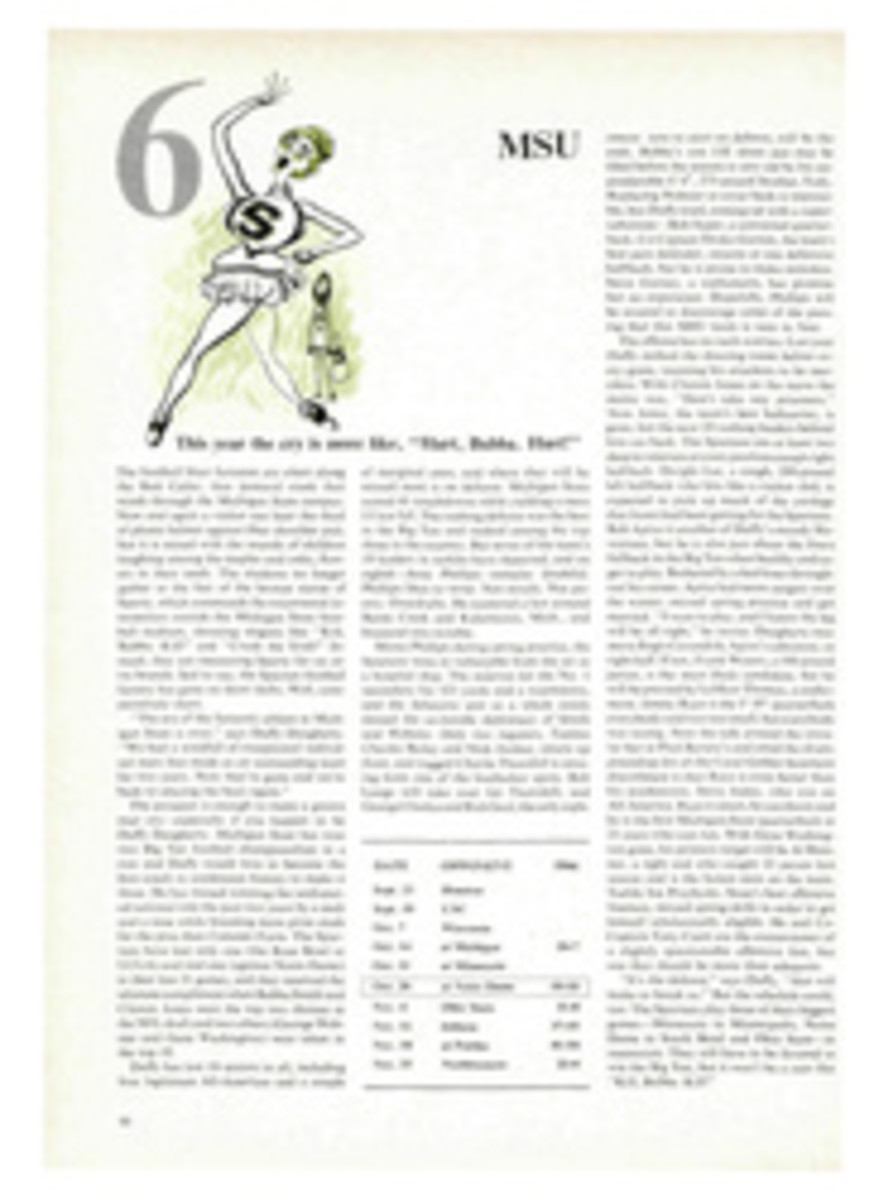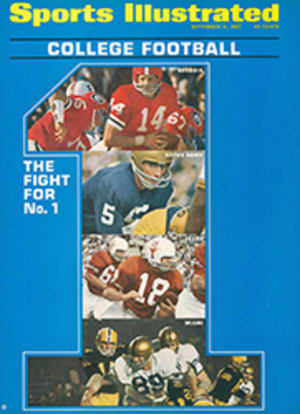
THE SMALL COLLEGE GIANTS
TENNESSEE STATE
John Merritt, the esteemed football coach of Tennessee State, will again spend his season staying as close as possible to The Lord's Prayer, since doing this has insured State's football success for the last three years. Nothing could be more logical. The Lord's Prayer, so named for his universal efficacy, and otherwise known as Eldridge Dickey, is a quarterback who has completed 68% of his passes in three seasons. In 1966 his output was 106 completions in 210 attempts for 25 touchdowns. Most of the time he throws right-handed. But not always. "He is accurate up to 25 yards left-handed," says Merritt. No coach in full possession of his faculties is going to let something like that get very far out of his sight.
Only once since he enrolled as a freshman has Dickey been back home to Houston. "That boy eats Christmas dinner with me," says Merritt. He does. Every year.
Nor is Dickey the only miracle-worker on this team. TSU Defensive Tackles Claude Humphrey and Tommie Davis have missed a Christmas dinner or two with their coach, but that is not meant to play down their worth—Merritt cannot afford to feed them on his salary. Humphrey weighs a solid, steady, calorie-consuming 254 and Davis 287. "Humphrey is the best in the nation," his coach says happily. "He will be a No. 1 draft choice. As for Davis, he's the toughest football player I've ever coached."
Merritt's opinion should count for something. He is 33-5 at Tennessee State and has 27 former players in professional ranks.
With Ends Elbert Drungo (6'5", 251) and Thomas McCord (6'3", 221) and Middle Guard Ken Brady (6', 232), the defensive line looks solid, and the linebacking is capable. But there are problems in the secondary. Five of TSU's six best defensive backs graduated (all five went to pro camps; indeed, all 10 of the Tigers' departed letter-men got looks by the pros). However, James Marsalis, the best one, returns.
On offense, Running Backs Wayne Reese and Leroy Motton, although both are 9.7 at 100 yards, will be pressed by freshman John Mayes and the much-sought, much-tested refugee from the University of Tennessee's admissions office, Albert Davis. When passing, Quarterback Dickey will have his choice of three senior receivers—Tight End Leo Johnson, Split End John Robinson and Flanker Joe Cooper—and will be protected by a very experienced line. Unbeaten in 24 straight games, Tennessee State has as much strength as ever.
SAN DIEGO STATE
TSU's principal concern is that it plays San Diego Slate in the first game of the season. San Diego may not have a Lord's Prayer. It does, however, have a Moses, a Teddy Washington and a McKinley Dillingham. Scouts call Haven Moses—a lean, intelligent lad with great speed—about the best pass receiver in collegiate football. Moses last year caught 57 passes for 1,145 yards, an average of 20 yards per reception, and scored eight touchdowns. Fullback Washington is a savage blocker and runner, and the 185-pound Dillingham averaged more than nine and a half yards per carry in 1966 at Sequoia Junior College. Then there is Halfback Lloyd Edwards who, at 6'4" and 242 pounds, runs 50 yards in 5.6.
Up in front of these running backs the Aztecs have what intense, aggressive Coach Don Coryell calls his best offensive line ever. Tackles Steve Duich and Dave Ogas, 262-pound Center Curt Hansen and a matched pair of guards, Paul Daniels and Clark Wright, both 6' and 225 pounds, constitute the muscles in the middle.
The front four on defense—sharp little bulldogs who hound enemy offensemen—are Larry Shakel, Cliff Hancock, Jim Hight and Dick Weber. None weighs as much as 200 pounds. Coryell's theory of defense is to put the small, mobile men up front and set two bruising linebackers right behind them to torture anything that escapes.
Both of last year's linebackers, along with the entire defensive backfield, have graduated, yet Coryell feels San Diego is starting 1967 with a better defensive secondary than before. His linebackers will be Dave Thornton, a converted offensive guard, and either transfer Mike Meagher or Doug Fisher, a junior-college discus thrower. The backs will be Jim Crossley, Ambrous Jacobs, an upgraded reserve, junior-college transfers Nate Wright, Marty Stigner and Clarence Oliver, and John Beck, a punter.
If that sounds like so many unknowns, consider it another way. When the professional draft was over last winter, eight men from little-known San Diego State had been selected—which tied it for first as a training center for pros with little-known Notre Dame and Michigan State. Two of the Aztecs went as first-round choices.
One of those drafted was Quarterback Don Horn. Junior-college transfers Tom Williams and Doug Matheson are still fighting for his position, and neither has looked exceptional.
San Diego's fiercest challenge may be its schedule. To celebrate a nice new $27 million stadium with some nice new gate receipts, the Aztecs piled Tennessee State, Weber State, Northern Illinois, Montana State and major-college Utah State on top of their California College Athletic Association games. The Aztecs will be bloodied at least once.
PARSONS
"Parsons College? Where is that?" says 230-pound Parsons Linebacker Ralph Young, quoting himself. Two years ago that was Young's not altogether novel reaction to his high school coach's suggestion of a place to go to school. "When he told me 'Iowa,' I somehow had the place confused with Ohio," says Young.
But Young's trip to Parsons to see the college and meet Coach Marcelino (Chelo) Huerta was most satisfactory, and now pro scouts come to Parsons to see Young. "I'd spent my freshman year at Southern Mississippi and wasn't happy," Young explains. "I couldn't go to most of the major schools because I'd lose a year of eligibility. Parsons was small, but it seemed to be doing things first-class."
Parsons' air travel has been all first-class too, ever since Huerta chartered the passing arm of Daynor Prince, a quarterback from Marblehead, Mass. Prince has completed 58.8% of his passes for 35 touchdowns in three years. Flanker Allen Marcelin grabbed 40 of those for 725 yards and six touchdowns last year alone. Halfback Ed Tuttle, who gained 390 yards rushing, returns this season, and Frank Antonini, a 210-pound transfer from Kentucky, is expected to look good on the other side.
The line is no problem at all. Last year Parsons' offensive and defensive lines were as big as Michigan State's. That's still true. Tackles Barry Connors, Ron Kittle and Jerry Campbell are all in the 255-270 class. Connors and Kittle are seniors, but Campbell is a junior. He is, says Huerta, "the finest lineman at this stage of his career that I've ever coached."
Huerta can't resist gloating a little over Campbell: "He was overlooked by Iowa and Iowa State. His coach at Roosevelt High in Des Moines thought he ought to have a chance somewhere, so he sent me some film. One look and we couldn't wait to get his name on a letter of intent."
Parsons' move into the top small-college ranks has been a hard one. "Some of the nearby colleges remember that not so many years ago we were a little Presbyterian school of 200," Huerta says. Last year Parsons went as far a field as Furman, Chattanooga, Idaho State, Los Angeles State and Hawaii to find opponents. Enrollment is now over 5,000, but as late as 1965, when Huerta arrived from Wichita State—where he had been Missouri Valley Coach of the Year—the practice field was in a gully and measured 50 yards by 60. Games were played in a high school stadium—a small one.
Last season Parsons scheduled its first three games away to allow for completion of a new stadium. "Los Angeles State arrived early in the week of our first home game," Huerta remembers. "Their coach said we'd never play a game there on Saturday unless all the spectators stood around the edge of the field. Only the concrete steps were poured. But in four days we got 8,000 permanent seats installed, 2,000 bleachers erected, goalposts put up, a scoreboard, a fence, two large prefab dressing buildings with showers, and a double-deck press box." Such is football enthusiasm at Parsons.
MONTANA STATE
Montana State is another of those teams with a nasty schedule (San Diego State, North Dakota State, Weber State, Fresno, West Texas State), practice fields so cluttered with broad-shouldered talent that the sun has trouble getting through to the grass, and a picturesquely nicknamed halfback, Don Hass, a rugged Little All-America from Glendive, Mont. "I like to call him the Iron Tumbleweed," says Coach Jim Sweeney. "My wife, Cile, prefers to call him Old Bread and Butter."
Dennis Erickson, a good option quarterback, can deal or keep like a Virginia City cardsharp, and Ron Bain is perhaps the best pass-receiving flanker ever seen at Montana State. Ray Becky and Henry Urza are more than adequate at fullback.
In the offensive line the resistance-wreckers are Guards Tony Wezenbach and Purnal Whitehead and Tackle Mickey Mathews. Defensively, Jerry Jamison is a strong guard and any play that comes near Linebackers Dennis Muhlbeier and Earl Hanson usually stops there.
Second-ranked by UPI last year, Montana State scored 394 points. Eighty-two of those came off the toe—or rather instep—of graduated Jan Stenerud, but MSU has imported another side-winding Norwegian kicker, Frank Kalfoss.
The Bobcats are in shape. None of them spent the summer on a lifeguard's stand. Jamison, for example, was a pipe layer. Kalfoss played soccer in Norway. Linebacker Hanson drove a truck and hiked up mountains. On one 25-mile trek into Glacier National Park he tangled with a grizzly, presumably a relative of the mascot of archrival Montana University. It must be reported that it was Hanson who climbed a tree. But all other omens and portents for the 1967 season are favorable.
NORTH DAKOTA STATE
You think North Dakota produces practically nothing but wheat and weather, and that most of the latter is bad? Or that the last good big runner in the state was an Ice Age mastodon? Then, you've not been reading the fine print in your sports section.
Admittedly, even Dakotans concede they once tended to share these feelings. North Dakota boys were bigger than the average, maybe, but there were just too few of them to build a football power. Then, on Sept. 25 1965, North Dakota State won its eighth consecutive game, and on Sept. 29 AP ranked the Bison first among the nation's small colleges. Even the players didn't believe it. Said NSDU President Dr. H. R. Albrecht, "It scares me to death."
There was only one thing for the country boys to do under the unaccustomed pressure: collapse. Instead, they went undefeated and won their first outright conference championship in 30 years. Last season they won eight more games, including ones against Montana State and North Dakota, before finally losing to San Diego State.
Feverish to keep this giddy notoriety, North Dakota State is encouraged by its best backfield yet. Halfback Ken Rota has been on Little All-America listings since his sophomore year. He scored 16 touchdowns that season and, despite being injured, eight in 1966. Quarterback Terry Hanson—a sprint-out type running a slot-I offense—threw 14 touchdown passes last season.
Aside from the front four, the defense is mature and dependable, featuring Dave Olson and Jim Ferge, who rejoin Mike Ahneman, an excellent field-goal kicker, at linebacker. Mike Berdis, a 285-pound tackle from Joliet, Ill., will help the weakened front wall—enormously.
"Now people are planning their vacations around our games," Athletic Director Richard Koppenhave: exults. "Before, they couldn't plan a satisfactory Saturday night."
ILLUSTRATION

